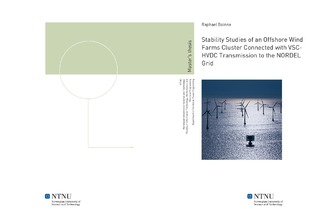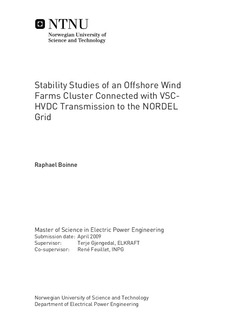| dc.contributor.advisor | Gjengedal, Terje | nb_NO |
| dc.contributor.advisor | Feuillet, René | nb_NO |
| dc.contributor.author | Boinne, Raphael | nb_NO |
| dc.date.accessioned | 2014-12-19T13:50:59Z | |
| dc.date.available | 2014-12-19T13:50:59Z | |
| dc.date.created | 2010-09-03 | nb_NO |
| dc.date.issued | 2009 | nb_NO |
| dc.identifier | 347733 | nb_NO |
| dc.identifier | ntnudaim:4786 | nb_NO |
| dc.identifier.uri | http://hdl.handle.net/11250/256511 | |
| dc.description.abstract | Offshore wind power has proven to be a renewable energy source with a high potential, especially in the North Sea, where an important development is going on. The location of the wind farms tends to move far from the coast to benefit stronger and more constant wind. In the same time, the power output of the wind farm is increasing to several hundreds of MW up to 1 GW. In the European liberalized electricity market, the interconnection of the countries become very important to facilitate the cross-border trade of electricity but also to improve the reliability of the grid. Combining this both aspects into one, a big offshore HVDC grid connecting countries and large wind farms spread allover the North Sea is currently being studied and developed. So in addition of the challenge given by a high penetration of the wind power production in the European power production scheme, new challenges are opened especially for the offshore transmission. This master thesis presents the integration to grid of a single 1 GW or a cluster of wind farms connected to an oil rig with different connection scheme based on HVDC transmission using the Voltage Source Converter (VSC) technology. The connection of the offshore wind farms is done either with a single HVDC transmission or two HVDC transmissions connected to the main grid at two different Points of Common Connection situated in the south-west of Norway. The wind farms are not represented in detail but by a single generator. They are equipped for the simulation with Double Fed Induction Generators (DFIG) to be representative of the reality, almost half of the wind turbines are today equipped with DFIG technology. Two disturbances are used to test the electrical stability of the system: a classical 150ms three fault phase in agreement with the grid code requirements on the ride fault through requirements and 100ms fault leading to the tripping of a line. The impact of using different types of generator is also investigated with the simulation of cluster wind farm where a wind farm is equipped with Fixed Speed Generator (FIG). The emphasis is put on the response of the VSC-converter and to a lesser extent on the behaviour of the wind turbine generator. It is demonstrated the capacity of the VSC-converter to stabilize a small grid alone and to isolate a disturbance. The voltage and the frequency offshore are practically unaffected by a fault onshore and vice versa. As expected, it is demonstrated that the multiplication of the VSC-HVDC converter in a grid improves the stability of the system. Finally, it has been noticed that there maybe some interactions if several different types of generators are used. The replacement of a generator by another type inside the wind farm cluster may change completely the dynamic behaviour after a disturbance. Simulations are performed with PSS/E. | nb_NO |
| dc.language | eng | nb_NO |
| dc.publisher | Institutt for elkraftteknikk | nb_NO |
| dc.subject | ntnudaim | no_NO |
| dc.subject | MSELPOWER Master of Science in Electric Power Engineering | no_NO |
| dc.subject | Elektrisk Energiteknikk | no_NO |
| dc.title | Stability Studies of an Offshore Wind Farms Cluster Connected with VSC-HVDC Transmission to the NORDEL Grid | nb_NO |
| dc.type | Master thesis | nb_NO |
| dc.source.pagenumber | 184 | nb_NO |
| dc.contributor.department | Norges teknisk-naturvitenskapelige universitet, Fakultet for informasjonsteknologi, matematikk og elektroteknikk, Institutt for elkraftteknikk | nb_NO |

